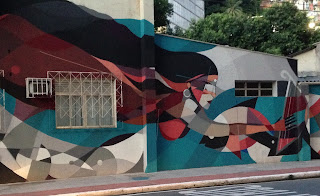Before
I left for Brasil, I knew I was headed to one of the most amazing places in the
world to see art on the street. Sure enough, right away I saw countless tags,
characters and beautifully rendered pieces around every corner.
The
legal standing of graffiti is different than what we’re accustomed to in the
U.S. It is still true that many places are off limits and the police will stop
you, but in many other places it’s considered ok, because it’s art. And this is
an important distinction. If your work is just writing or some version of Pichação
(the traditional protest script or wall writing now appropriated by thrill
seeking young men who hang off buildings to see who can hit the most
inaccessible spots) you’re much more likely to be stopped, but if you’re making
colorful imagery that is in the same vain as other pieces in the area, you’re
fine. Basically this means there are free walls everywhere to express
yourself. What a paradigm shift.
What
I haven’t seen here are collaborative community-based murals, and I’m just
beginning to understand the reasons why. Art, visual art that is, is still
considered to be predominantly an individual pursuit – especially graffiti where,
although there are crews who paint next to each other, artists maintain their
highly individual styles and “tags”. They rarely work with non-artists or on
projects that develop and paint designs collectively.
Kaleb,
a graffiti artist I’m working with in São Paulo, has been really fascinated
with my approach – the time we take, the alchemy of the design process and the
collective spirit. He wondered today if I had studied sociology in addition to
art because of my methods.
Below
is just a taste of what I’ve seen. I’ll be adding the artist’s names as I
learn them.
 |
| Vix |
 |
| Mural about the tradition of the Paneleiras - women pot makers |
 |
| "How many women have already been harassed on this street?" |
 |
| One of the few community murals I've seen |
São Paulo
 |
| Alexandre Keto |
 |
| Kaleb |
 |
| OZI |
 |
| Feik |
 |
| Mundano |


















No comments:
Post a Comment